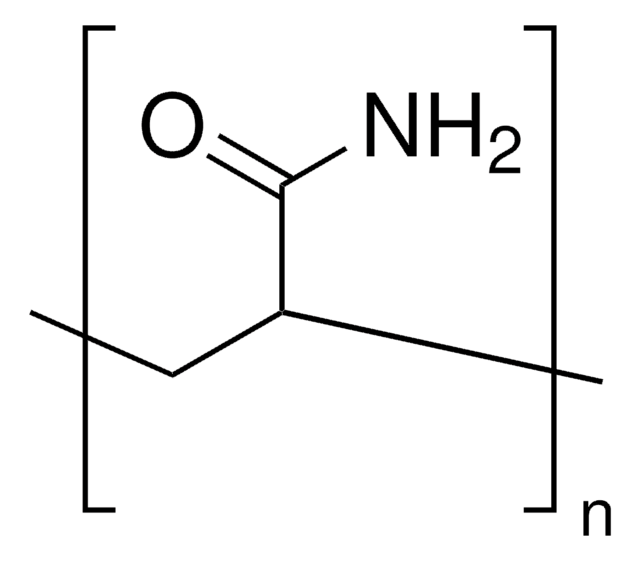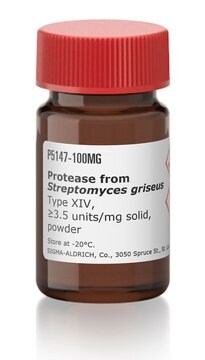181609
Polycaprolactone
average Mw ~65,000, average Mn ~42,500, pellets
Sinonimo/i:
2-Oxepanone homopolymer, 6-Caprolactone polymer
Autenticatiper visualizzare i prezzi riservati alla tua organizzazione & contrattuali
About This Item
Formula condensata:
(C6H10O2)n
Codice UNSPSC:
12162002
Prodotti consigliati
Stato
pellets
Indice di fluidità
1.9 g/10 min (80°C/0.3 Mpa)
PM
average Mn ~42,500
average Mw ~65,000
Resistenza all’urto
82 J/m (Izod, ASTM D 256-73A, notched)
Durezza
55 (Shore D, ASTM D 2240-75)
Punto di fusione
60 °C (lit.)
Allungamento
2 in/min - 600-1000% (ultimate)
Cerchi prodotti simili? Visita Guida al confronto tra prodotti
Applicazioni
Extrusion aid, die lubricant, mold release, pigment and filler dispersion aid and polyester segments in urethanes and block polyesters.
Caratteristiche e vantaggi
Biodegradable polymer
Non-toxic, biodegradable in soil, broad miscibility, mechanical compatibility with many polymers and good adhesion to a broad spectrum of substrates.
Non-toxic, biodegradable in soil, broad miscibility, mechanical compatibility with many polymers and good adhesion to a broad spectrum of substrates.
Codice della classe di stoccaggio
11 - Combustible Solids
Classe di pericolosità dell'acqua (WGK)
WGK 3
Punto d’infiammabilità (°F)
Not applicable
Punto d’infiammabilità (°C)
Not applicable
Dispositivi di protezione individuale
Eyeshields, Gloves, type N95 (US)
Scegli una delle versioni più recenti:
Possiedi già questo prodotto?
I documenti relativi ai prodotti acquistati recentemente sono disponibili nell’Archivio dei documenti.
Wei Ching Low et al.
Biomaterials, 34(14), 3581-3590 (2013-02-19)
At present, the recovery prospect for patients with chronic neurodegenerative diseases or acute trauma in the central nervous system is sub-optimal. The controlled differentiation of neural stem/progenitor cells (NPCs) to functional neurons is a possible treatment strategy. In contrast to
Mi-Jin Kim et al.
Materials science & engineering. C, Materials for biological applications, 33(4), 2266-2272 (2013-03-19)
We synthesized poly(ε-caprolactone) (PCL)/hydroxyapatite (HA) composite microspheres with an aligned porous structure and evaluated their potential applications in bone tissue engineering. A range of HA particles (0, 5, 10 and 20 wt.% in relation to the PCL polymer) were added
Kalaipriya Madhaiyan et al.
International journal of pharmaceutics, 444(1-2), 70-76 (2013-02-02)
Biocompatible PCL polymer nanofiber mediated sustained release of hydrophilic drug and applicability as transdermal delivery system is attempted. This new attempt to investigate water soluble vitamin delivery with hydrophobic polymer nanofiber sustained the release of the vitamin and the method
P R Sreerekha et al.
Journal of biomedical nanotechnology, 9(5), 790-800 (2013-06-28)
Fabricating scaffolds mimicking the native extracellular matrix (ECM) in both structure and function is a key challenge in the field of tissue engineering. Previously we have demonstrated a novel electrospinnig method for the fabrication of fibrin nanofibers using Poly(vinyl alcohol)
Qingchun Zhang et al.
Materials science & engineering. C, Materials for biological applications, 33(4), 2094-2103 (2013-03-19)
The physical properties of tissue engineering scaffolds such as microstructures play important roles in controlling cellular behaviors and neotissue formation. Among them, the pore size stands out as a key determinant factor. In the present study, we aimed to fabricate
Il team dei nostri ricercatori vanta grande esperienza in tutte le aree della ricerca quali Life Science, scienza dei materiali, sintesi chimica, cromatografia, discipline analitiche, ecc..
Contatta l'Assistenza Tecnica.





